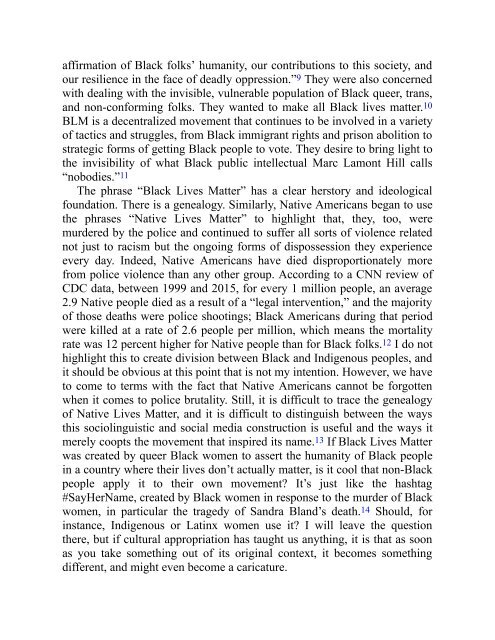Create successful ePaper yourself
Turn your PDF publications into a flip-book with our unique Google optimized e-Paper software.
affirmation <strong>of</strong> Black folks’ humanity, our contributions to this society, and<br />
our resilience in <strong>the</strong> face <strong>of</strong> deadly oppression.” 9 They were also concerned<br />
with dealing with <strong>the</strong> invisible, vulnerable population <strong>of</strong> Black queer, trans,<br />
and non-conforming folks. They wanted to make all Black lives matter. 10<br />
BLM is a decentralized movement that continues to be involved in a variety<br />
<strong>of</strong> tactics and struggles, from Black immigrant rights and prison abolition to<br />
strategic forms <strong>of</strong> getting Black people to vote. They desire to bring light to<br />
<strong>the</strong> invisibility <strong>of</strong> what Black public intellectual Marc Lamont Hill calls<br />
“nobodies.” 11<br />
The phrase “Black Lives Matter” has a clear herstory and ideological<br />
foundation. There is a genealogy. Similarly, Native Americans began to use<br />
<strong>the</strong> phrases “Native Lives Matter” to highlight that, <strong>the</strong>y, too, were<br />
murdered by <strong>the</strong> police and continued to suffer all sorts <strong>of</strong> violence related<br />
not just to racism but <strong>the</strong> ongoing forms <strong>of</strong> dispossession <strong>the</strong>y experience<br />
every day. Indeed, Native Americans have died disproportionately more<br />
from police violence than any o<strong>the</strong>r group. According to a CNN review <strong>of</strong><br />
CDC data, between 1999 and 2015, for every 1 million people, an average<br />
2.9 Native people died as a result <strong>of</strong> a “legal intervention,” and <strong>the</strong> majority<br />
<strong>of</strong> those deaths were police shootings; Black Americans during that period<br />
were killed at a rate <strong>of</strong> 2.6 people per million, which means <strong>the</strong> mortality<br />
rate was 12 percent higher for Native people than for Black folks. 12 I do not<br />
highlight this to create division between Black and <strong>Indigenous</strong> peoples, and<br />
it should be obvious at this point that is not my intention. However, we have<br />
to come to terms with <strong>the</strong> fact that Native Americans cannot be forgotten<br />
when it comes to police brutality. Still, it is difficult to trace <strong>the</strong> genealogy<br />
<strong>of</strong> Native Lives Matter, and it is difficult to distinguish between <strong>the</strong> ways<br />
this sociolinguistic and social media construction is useful and <strong>the</strong> ways it<br />
merely coopts <strong>the</strong> movement that inspired its name. 13 If Black Lives Matter<br />
was created by queer Black women to assert <strong>the</strong> humanity <strong>of</strong> Black people<br />
in a country where <strong>the</strong>ir lives don’t actually matter, is it cool that non-Black<br />
people apply it to <strong>the</strong>ir own movement? It’s just like <strong>the</strong> hashtag<br />
#SayHerName, created by Black women in response to <strong>the</strong> murder <strong>of</strong> Black<br />
women, in particular <strong>the</strong> tragedy <strong>of</strong> Sandra Bland’s death. 14 Should, for<br />
instance, <strong>Indigenous</strong> or Latinx women use it? I will leave <strong>the</strong> question<br />
<strong>the</strong>re, but if cultural appropriation has taught us anything, it is that as soon<br />
as you take something out <strong>of</strong> its original context, it becomes something<br />
different, and might even become a caricature.


















